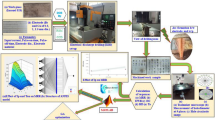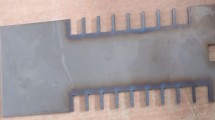Abstract
The article is focused on maximizing the dimensions of a hole drilled through repetitive pulsed laser drilling process by employing the artificial neuro-fuzzy inference system (ANFIS) and multi-objective Genetic Algorithm (GA) with the help of the data obtained from numerical modelling. An axisymmetric two-dimensional numerical model is developed for studying this repetitive pulse laser drilling process in a cylindrical work piece to determine the drilled hole depth and radius and the temperature at the point of laser application. The governing differential equations are discretized using the Finite volume method and the Tri-Diagonal Matrix Algorithm is used to solve the resulting algebraic equations to obtain temperature distribution inside the computational domain. The Enthalpy-Porosity method is used to track the solid-liquid interface during the melting process. The laser source considered here is Gaussian and volumetric in nature and the computations are carried out taking different laser parameters like energy, number of pulses, pulse width, duty cycle and beam radius. The artificial intelligence method ANFIS is adopted to model the process using the result data obtained from numerical investigation. Separate ANFIS models are developed for the prediction of the depth, radius, center temperature, HAZ and taperness of the simulated drilled hole. These models are used as objective functions for a multi-objective genetic algorithm program to get a set optimal solutions for maximizing the depth and radius of the drilled hole and the temperature at the point of laser application in an objective to achieve highest material removal. Another section is also presented carrying out the multi-objective optimisation of considering maximiisation of radius, depth and center temperature along with minimisation of the HAZ and the tapoerness of the hole.















Similar content being viewed by others
Abbreviations
- ap :
-
co-efficient in the discretized algebraic equation
- α 0 :
-
radius of laser beam
- Cp :
-
specific heat
- g:
-
gravitational acceleration
- g L :
-
volume fraction of liquid
- hsen :
-
sensible heat
- h:
-
convective coefficient of heat transfer
- H:
-
enthalpy
- E:
-
laser energy
- Io :
-
peak intensity of laser beam
- k:
-
thermal conductivity
- Lf :
-
latent heat of fusion
- ms:
-
millisecond
- SLS :
-
laser source term
- Sh :
-
enthalpy source term
- Sr :
-
r-momentum source term
- Sz :
-
z-momentum source term
- T:
-
temperature
- t:
-
time
- ton :
-
on time
- toff :
-
off time
- u:
-
z-component of velocity
- v:
-
r-component of velocity
- r,z :
-
cylindrical coordinate directions
- N:
-
number of pulses
- V:
-
resultant velocity
- mf:
-
membership function
- a, b, c:
-
parameters used in ANFIS modelling
- κ:
-
absorption coefficient
- α:
-
thermal diffusivity
- λ:
-
under-relaxation parameter
- β:
-
volumetric thermal expansion coefficient
- ρ:
-
density
- μ:
-
dynamic viscosity
- σ:
-
Stefan-Boltzmann constant
- τ:
-
pulse width
- Δt:
-
time step size
- ΔH :
-
nodal latent heat
- ΔV:
-
volume of a control volume
- m:
-
melting point
- v:
-
boiling point
- P:
-
control volume
- nb:
-
neighbouring nodes
- ref:
-
reference
- 0:
-
initial time when t = 0
- n:
-
number of iteration
- o:
-
previous time step
References
Nakhjavani, O.B., Ghoreishi, M.: Multi criteria optimization of laser percussion drilling process using artificial neural network model combined with genetic algorithm. Mater. Manuf. Process. 21(1), 11–18 (2006)
Olabi, A.G., Casalino, G., Benyounis, K.Y., Hashmi, M.S.J.: An ANN and Taguchi algorithms integrated approach to the optimization of CO2laser welding. Adv. Eng. Softw. 37(10), 643–648 (2006)
Park, Y.W., Rhee, S.: Process modeling and parameter optimization using neural network and genetic algorithms for aluminum laser welding automation. Int. J. Adv. Manuf. Technol. 37(9-10), 1014–1021 (2008)
Dhara, S.K., Kuar, A.S., Mitra, S.: An artificial neural network approach on parametric optimization of laser micro-machining of die-steel. Int. J. Adv. Manuf. Technol. 39(1-2), 39–46 (2008)
Assarzadeh, S., Ghoreishi, M.: Neural-network-based modeling and optimization of the electro-discharge machining process. Int. J. Adv. Manuf. Technol. 39(5-6), 488–500 (2008)
Missori, S., Sili, A., Ucciardello, N.: Process parameters optimization of laser beam welded joints by neural network. Mater. Manuf. Process. 23, 169–174 (2008)
Ghoreishi, M., Nakhjavani, O.B.: Optimisation of effective factors in geometrical specifications of laser percussion drilled holes. J. Mater. Process. Technol. 196(1-3), 303–310 (2008)
Dhupal, D., Doloi, B., Bhattacharyya, B.: Modeling and optimization on Nd:YAG laser turned micro-grooving of cylindrical ceramic material. Opt. Lasers Eng. 47(9), 917–925 (2009)
Karazi, S.M., Issa, A., Brabazon, D.: Comparison of ANN and DoE for the prediction of laser-machined micro-channel dimensions. Opt. Lasers Eng. 47(9), 956–964 (2009)
Sharma, A., Yadava, V.: Modelling and optimization of cut quality during pulsed Nd:YAG laser cutting of thin Al-alloy sheet for straight profile. Opt. Laser Technol. 44(1), 159–168 (2012)
Kumar Pandey, A., Kumar Dubey, A.: Simultaneous optimization of multiple quality characteristics in laser cutting of titanium alloy sheet. Opt. Laser Technol. 44(6), 1858–1865 (2012)
Mishra, S., Yadava, V.: Modeling and optimization of laser beam percussion drilling of thin aluminum sheet. Opt. Laser Technol. 48, 461–474 (2013)
Goyal, R., Dubey, A.K.: Quality improvement by parameter optimization in laser trepan drilling of superalloy sheet. Mater. Manuf. Process. 29(11-12), 1410–1416 (2014)
Sohrabpoor, H.: Analysis of laser powder deposition parameters: ANFIS modeling and ICA optimization. Optik (Stuttg). 127, 4031–4038 (2016)
Akbari, M., Saedodin, S., Panjehpour, A., Hassani, M., Afrand, M., Torkamany, M.J.: Numerical simulation and designing artificial neural network for estimating melt pool geometry and temperature distribution in laser welding of Ti6Al4V alloy. Optik (Stuttg). 127, 11161–11172 (2016)
Seabra, M., Azevedo, J., Araújo, A., Reis, L., Pinto, E., Alves, N., Santos, R., Pedro Mortágua, J.: Selective laser melting (SLM) and topology optimization for lighter aerospace componentes. Proc Struct Integr. 1, 289–296 (2016)
Bai, Y., Yang, Y., Xiao, Z., Zhang, M., Wang, D.: Process optimization and mechanical property evolution of AlSiMg0.75 by selective laser melting. Mater. Des. 140, 257–266 (2018)
Mao, Z., Zhang, D.Z., Jiang, J., Fu, G., Zhang, P.: Processing optimisation, mechanical properties and microstructural evolution during selective laser melting of Cu-15Sn high-tin bronze. Mater. Sci. Eng. A. 721, 125–134 (2018)
Basu, B., Srinivasan, J.: Numerical study of steady-state laser melting problem. Int. J. Heat Mass Transf. 31(11), 2331–2338 (1988)
Kar, A., Mazumder, J.: Two-dimensional model for material damage due to melting and vaporization during laser irradiation. J. Appl. Phys. 68(8), 3884–3891 (1990)
Zhu, X., Naumov, A.Y., Villeneuve, D.M., Corkum, P.B.: Influence of laser parameters and material properties on micro drilling with femtosecond laser pulses. Appl. Phys. A Mater. Sci. Process. 69, 367–371 (1999)
Yilbas, B.S., Naqvi, I.Z.: Laser heating including the phase change process and thermal stress generation in relation to drilling. Proc. Inst. Mech. Eng. Part B J. Eng. Manuf. 217(7), 977–991 (2003)
Shuja, S.Z., Yilbas, B.S., Khan, S.M.A.: Laser consecutive pulse heating in relation to melting: influence of duty cycle on melting. Heat Mass Transf. 45(6), 793–803 (2009)
Qin, Y., Wang, B., Ni, X.W., Shen, Z.H., Lu, J.: Axisymmetric analytical solution for pulsed laser melting of metals. Comput. Mater. Sci. 54, 1–6 (2012)
Afrin, N., Ji, P., Chen, J.K., Zhang, Y.: Effects of beam size and pulse duration on the laser drilling process. (2016). https://doi.org/10.1115/HT2016-7339
Chen, G., Wang, Y., Jhang, J., Bi, J.: An analytical solution for two-dimensional modeling of repetitive long pulse laser heating material. Int. J. Heat Mass Transf. 104, 503–509 (2017)
Gautam, G.D., Pandey, A.K.: Pulsed Nd:YAG laser drilling : a review. Opt. Laser Technol. 100, 183–215 (2018)
Safari, M., Farzin, M.: Experimental investigation of laser forming of a saddle shape with spiral irradiating scheme. Opt. Laser Technol. 66, 146–150 (2015)
Safari, M., Mostaan, H., Farzin, M.: Laser bending of tailor machined blanks: effect of start point of scan path and irradiation direction relation to step of the blank. Alex. Eng. J. 55(2), 1587–1594 (2016)
Safari, M., Farzin, M., Mostaan, H.: A novel method for laser forming of two-step bending of a dome shaped part. Iranian Journal of Materials Forming. 4, 1–14 (2017)
Safari, M., Joudaki, J.: Prediction of bending angle for laser forming of tailor machined blanks by neural network. 5, 47–57 (2018)
Safari, M.: A study on the laser tube bending process: effects of the irradiating length and the number of irradiating passes. Iranian Journal of Materials Forming. 7, 46–53 (2020)
Bhardwaj, T., Shukla, M.: Laser additive manufacturing- direct energy deposition of Ti-15Mo biomedical alloy: artificial neural network based modeling of track dilution. Lasers Manuf. Mater. Process. 7(3), 245–258 (2020)
Kochar, P., Sharma, A., Suga, T., Tanaka, M.: Prediction and control of asymmetric bead shape in laser-arc hybrid fillet-lap joints in sheet metal welds. Lasers Manuf. Mater. Process. 6(1), 67–84 (2019)
Chaki, S., Bose, D., Bathe, R.N.: Multi-objective optimization of pulsed Nd: YAG laser cutting process using entropy-based ANN-PSO model. Lasers Manuf. Mater. Process. 7(1), 88–110 (2020)
Saini, S.K., Dubey, A.K., Pant, P., Upadhyay, B.N., Choubey, A.: Study of laser drilled hole quality of Yttria stabilized zirconia. Lasers Manuf. Mater. Process. 4(3), 121–135 (2017)
Tadamalle, A.P., Reddy, Y.P., Ramjee, E., Reddy, V.K.: Evaluation of distortion and residual stresses in dissimilar metal laser welds. Lasers Manuf. Mater. Process. 6(4), 374–386 (2019)
Golabi, S., Vakil, M.R., Amirsalari, B.: Multi-objective optimization of residual stress and cost in laser shock peening process using finite element analysis and PSO algorithm. Lasers Manuf. Mater. Process. 6(4), 398–423 (2019)
Farahmand, P., Kovacevic, R.: Parametric study and multi-criteria optimization in laser cladding by a high power direct diode laser. Lasers Manuf. Mater. Process. 1(1-4), 1–20 (2014)
Patankar, S.V.: Numerical Heat Transfer and Fluid Flow, Hemisphere, London (1980)
Brent, A.D., Voller, V.R., Reid, K.J.: Enthalpy-porosity technique for modeling convection - diffusion phase change: application to the melting of a pure metal. Numer. Heat Transf. 13, 297–318 (1988)
Deb, K.: Multi-Objective Optimization Using Evolutionary Algorithms. Wiley, New York (2001)
Haupt, R.L., Haupt, S.E.: Practical Genetic Algorithms. Wiley, New Jersey (2004)
Author information
Authors and Affiliations
Corresponding author
Additional information
Publisher’s Note
Springer Nature remains neutral with regard to jurisdictional claims in published maps and institutional affiliations.
Rights and permissions
About this article
Cite this article
Sukumar, S., Kar, S.P., Swain, A. et al. A Combined CFD, ANFIS and NSGA-II Model for Repetitive Pulse Laser Drilling Process. Lasers Manuf. Mater. Process. 7, 449–477 (2020). https://doi.org/10.1007/s40516-020-00127-x
Accepted:
Published:
Issue Date:
DOI: https://doi.org/10.1007/s40516-020-00127-x




